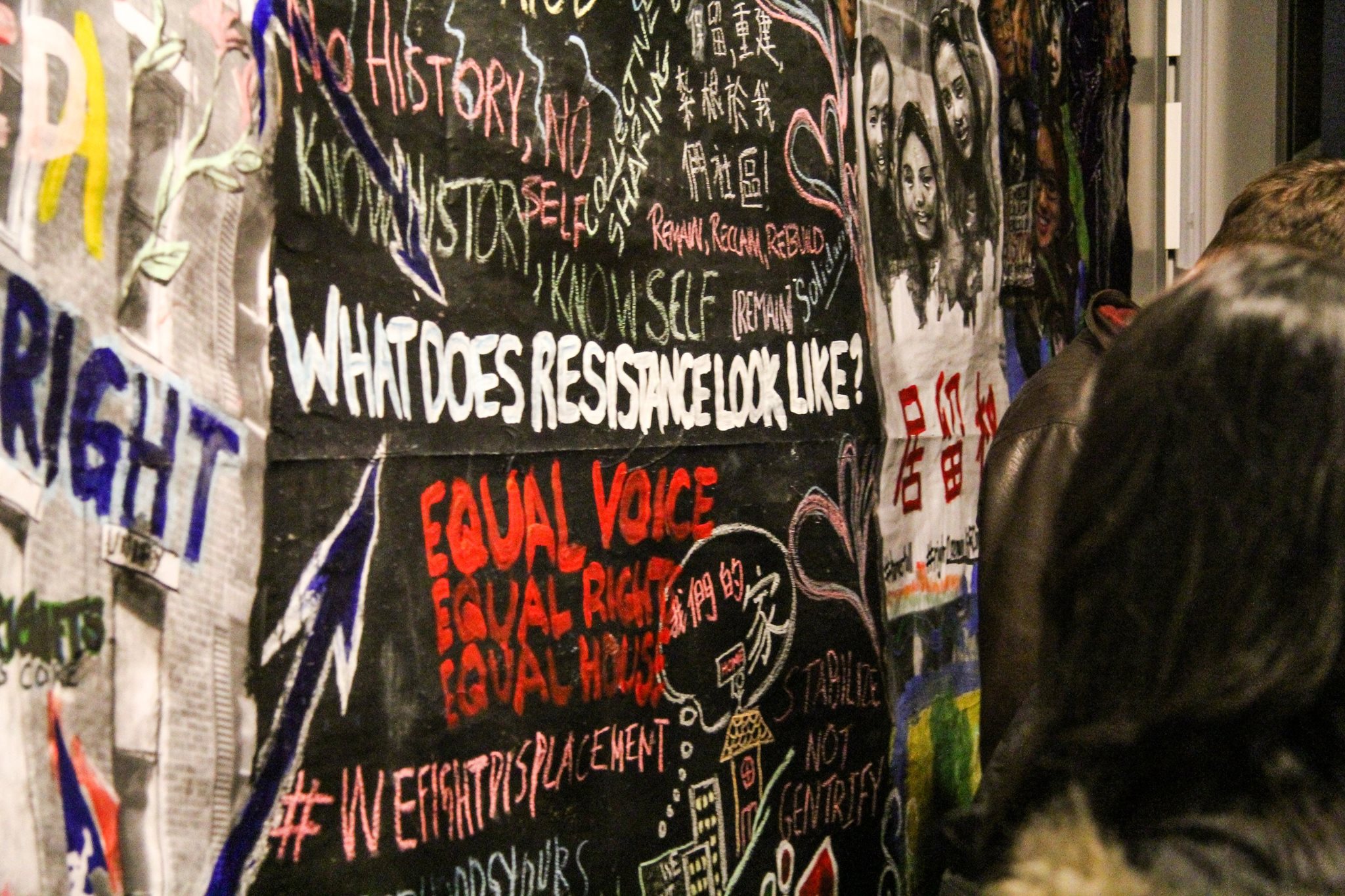V I S I O N S
PHOTO•FILM•DESIGN•ILLUSTRATION•3D ARTS
The People First!, a gallery show at EMW Bookstore on display from March to May 2016, reflects on a particular moment in the Boston housing movement. Artists from local neighborhoods offer pieces that engage with both personal narratives and collective memories. Bringing together stories from various neighborhoods in the Greater Boston Area, we hope to present a connected network of the efforts fighting against gentrification.
Tenant movement in the Greater Boston Area has been one of the main activism campaigns since the ‘50s. When Mayor Hynes introduced the city plan known as “The New Boston,” he inadvertently allowed the demolition of thousands of houses and the forced separation of countless families in order to bolster a dying economy. The Boston we live in today has the one of the strongest economies in the country; however, we should remember that these economic and urban improvements are built upon the remains of local cultures, such as those of the South End, East Boston, Roxbury/Dorchester, and more.
The People First! is a call for all who consider the Greater Boston Area their community and home. A neighborhood is its People.
**Trigger warning: this gallery contains images of violence and death.*
Measuring lives in numbers, statistics, and data points dominates mainstream discourse about public tragedies. Those who die in mass, especially the subaltern, are reduced to numerical archives. By reporting deaths as numbers, we devalue the lives lost and the lives they leave behind. In the aftermath, families search for the physical remains of missing loved ones. For them, closure may come in the form of a casket or may never be found, where physical remains are lost in rubble or a desert landscape."
In 2013, thousands perished during the Rana Plaza factory collapse in Bangladesh. Every year, thousands more are lost while migrating across the Sonoran Desert of Mexico and Arizona. In their first collaboration, documentary photographers Atish Saha and Bryan MacCormack present a series of photographs to reveal the lives behind the numbers reported in these two separate events.
Artists Against Police Violence is proud to present our first exhibit in collaboration with EMW Bookstore. In October of 2014, we launched a national call for submissions calling all artists to rise up against anti-Black police violence as an urgent response to the numerous protests erupting in Ferguson and across America. The pieces gathered from this call became ArtistsAgainstPoliceViolence.com – a diverse online resource featuring paintings, posters, zines, and various print and moving media collected to be used on the streets, the internet and beyond. Here is a collection of work that remembers, mourns, and celebrates Black people who were killed by police, and honors the trauma and resistance that follow.
The exhibit strives to recenter the political intentions behind #BlackLivesMatter - which recognizes that anti-Black state violence encompasses much more than police murders of Black men, but also poverty, incarceration, ableism, and gender oppression -- as well as all the Black women and gender non-conforming people who have always led the movement in Ferguson, in Baltimore, and throughout history. Here is a constellation work by primarily Black artists, artists of color, and queer and trans artists visualizing the movement today.
Translated from the Portuguese term conscientização and developed by educational theorist Paulo Freire, conscientization refers to the process by which one develops a critical consciousness of one’s social reality through reflection and action. The artist’s piece "Conscientization" contemplates the role of higher education for young, working class women of color at Wellesley College. While popular education (education as a practice of freedom) is liberating and empowering, the artist highlights the silent struggles surrounding consciousness raising, including struggles of identity, community ties, and preserving one’s history.
The piece was created through online submissions from Wellesley College’s Latina student body for the annual Mezcla (Wellesley's Latinx organization) 2016 poster campaign. Statements were hand painted by a group of students and then digitized and designed into a series of twenty-four posters by the artist. The artist herself is a first generation college student of Mexican and Korean heritage.
A red-crowned crane representing East Asia, a kingfisher representing South Asia and a white-tailed tropic bird representing the Pacific Islands. Patterning their wings is a motif taken from signs that riddle highways along the US/Mexico Border, signifying the crossing of undocumented immigrants. The birds are soaring through a wire border strung with bodies that never made the journey to the other side. The crossing of every border, be it a body of water between America and Asia, or the fence that lines USA and Mexico, is a kind of transformation. This transformation comes at an incredible cost of leaving behind a homelands' languages, heritages and communities, often at the risk of life itself. Immigration is driven by an undefeatable optimism for better life – mother and child become a migratory bird as they triumph enormous struggles and distances to reclaim life and community in a new country. This installation is dedicated to Americas' invisibilized immigrant communities as their spirits continue to soar.
More from Jess X Chen: IG @jessxchen and www.jessxchen.com


![Lives Not Numbers [Atish Saha & Bryan MacCormack]](https://images.squarespace-cdn.com/content/v1/54da8488e4b07abb4710aaba/1464487495680-2QJ8GHHP93X6S3PLIW5Q/29.jpg)
![Black Lives Matter [Artists Against Police Violence]](https://images.squarespace-cdn.com/content/v1/54da8488e4b07abb4710aaba/1459627819827-VAAII5SKSXF2QLPMWZ70/image-asset.jpeg)
![Conscientization [Elizabeth Cho & Wellesley Mezcla]](https://images.squarespace-cdn.com/content/v1/54da8488e4b07abb4710aaba/1466048891613-GWRN0HCRJ4F90QZ7BDSA/11070201_10155422842670343_8071609937299062571_n.jpg)
![Migration: Birds <br>[Jess X Chen]](https://images.squarespace-cdn.com/content/v1/54da8488e4b07abb4710aaba/1459612873181-94P0XX8811PC50YOXQ1R/crane_jessxchen_300-saturate.jpg)
A visual collaboration with a letter written by a Honduran mother who is being kept at Karnes County Detention Center with her younger son after attempting to cross the border to be re-united with her family. Despite the traumatic and abusive conditions she faces at Karnes, she and her younger son reach across the US/Mexico Border to join hands with her older son who made it to Los Angeles. Their bodies are preserved with the light of a million stars, representing the millions of mothers, fathers, and children throughout history who attempt to cross the border into the US. Migrants risk enormous loss in the optimism of securing family and community in a new country. For as long as she lives, the Honduran mother, and millions others, reach for each other and form constellations in the night despite the borders, detainments, and abuse of the US. This image is a tribute to their undefeatable optimism and resilience. Read the original letter here.
Commissioned for Culture Strike's Visions From The Inside Project
More from Jess X Chen: IG @jessxchen and www.jessxchen.com